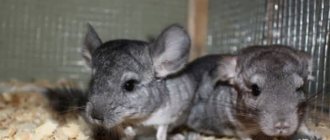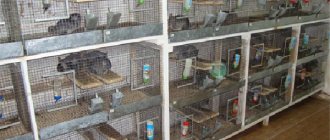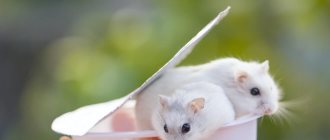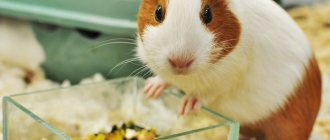- Characteristics of fur
- Advantages of business Conditions of maintenance
- Expenses
- Profit
Breeding chinchillas is a very interesting activity, which, with the right approach, calculation and established sales, can bring considerable profit. After all, animal skins can be sold profitably or you can sew a fur coat, fur collar, or hat yourself. How much time, money and effort needs to be spent in Russia in order for the cultivation of chinchillas to begin to make a profit - this is the subject of today’s conversation. We will also find out how much a chinchilla skin costs in our country and where to contact regarding the sale of goods. But first things first.
Breeding chinchillas in Russia is a very promising business and a very decent business, which can be based on the cultivation and sale of the animals themselves, as well as the sale of skins for fur coats. How much does a breeding animal cost for sale? The price may vary within 100 USD. However, today we will talk about the sale of chinchilla skins, the peculiarities of doing business and risks.
To begin with, all beginners need to draw up a small business plan, which will include basic organizational, legal, and business expenses. It outlines the prospects for doing business and describes the sale of the final product.
Characteristics of fur
In addition to dietary meat, chinchilla is very valuable due to its fluffy skin. They can be used to make fur coats, hats, fur products and much more. This direction, among others, is the most profitable and promising in our country. Fur is valuable due to the presence of a huge number of hairs (on average, there are about 25 thousand hairs per 1 cm square) and incredible beauty and silkiness. However, you can combine several areas of business and simultaneously sell meat, sell skins and sell live animals.
How much does a chinchilla skin cost? This is a very important question for those new to chinchilla breeding. Much in the pricing policy depends on the quality of the skin and the appearance of the product. But on average, the price of the finished product varies from 250 to 300 USD. The cost of top quality skins on the market can increase several times.
How much can you buy a live chinchilla for?
The price of an animal with valuable fur can vary significantly for the following reasons:
- Fur color. Most chinchillas have a gray color, but sometimes you can find an original rare color caused by a gene mutation. Animals with such a valuable color or carriers of similar recessive genes with a pedigree will be more expensive. Among other things, the color must be free of defects, that is, the color must be uniform, and in ebony the belly is identical to the back.
- Fur quality. Particularly valued are individuals with a high density of fur, in which the height of the fur in different parts of the body is the same, and the fur coat is silky and elastic. If you inflate the fur of a chinchilla, the skin is almost invisible, the hairs instantly close together. Animals with short fur are more preferable. A defect is considered to be sparse, matted and split fur, uneven coat, long lying hairs, curls.
- Exterior. The individual must have a proportionate, strong physique. In a chinchilla, the width of the sacrum and back is almost identical. From above, the animal looks like a brick with rounded edges. Nature has endowed these individuals with a short head with eyes set on a short neck. The optimal weight of a chinchilla is from 600 to 800 grams. Samples with rounded ears look touching and cute.
- Floor. Females are rated higher because more males are born. In addition, a male is able to live with 2 or more females.
- Place of purchase. In the pet store and on the market the price will be several times lower than in the nursery.
The cost of chinchillas with rare colors is gradually decreasing, because when buying an animal, people do not always pay attention to the subtleties of color and do not want to overpay.
In Russia, it is quite possible to buy a rodent from 500 rubles to 40 thousand. And the winner of exhibitions can even cost 200 thousand rubles. As you can see, prices vary quite significantly. Carriers of valuable colors and genetics are valued more expensively.
Advantages of business
- Financial benefit. With a small investment of capital, you receive net income in a short period of time;
- Availability. This type of business can be done by absolutely anyone who has a small premises and a great desire to open their own business from scratch. This does not require special in-depth knowledge, veterinary education, or a lot of money. You need to have desire and strength;
- Simplicity. In fact, it is not very difficult to start breeding chinchillas and organize the work correctly.
It is not difficult to make an approximate calculation of your future business and you do not need financial education for this. The first thing you should pay attention to is that chinchilla breeding can be done in an apartment or private house. The thing is that these animals do not have an unpleasant odor due to the lack of sweat glands. Therefore, you can safely grow them in an apartment without fear that they will emit a bad aroma. In addition, they are very friendly, unlike, for example, muskrats, which constantly bite. Chinchillas are very sweet and kind creatures that can even bite off their claws on their own! Cages for animals are a separate topic, but you can make them yourself, or purchase them in special zoological stores.
Conditions of detention
Chinchillas have some characteristic features on which their breeding depends. This:
- Compliance with the temperature regime, which varies from 15 to 20 degrees. It is very important to prevent a decrease in indicators, as well as an increase of more than 25 degrees. This can lead to the death of the animal. Therefore, if hot days are possible in your climate zone, it is better to immediately equip the room with air conditioning;
- Location. Try not to place cages with chinchillas near a window, because... animals don't like sunlight. Also avoid any players with loud music or other sounds;
- The cages should be roomy, but not high, so that the animal cannot break. There must be at least one square meter of cage area per individual;
- The inside of the cage is lined with sawdust, which needs to be changed at least once a week. In addition, each cage should have a bath with special ash, a feeder and a drinking bowl;
- Animals eat hay, tree branches, grasses, granulated feed, grains, nuts and much more;
- Chinchilla is a nocturnal resident. That's why she feeds at night. Just like it fulfills all other needs, it is worth paying special attention to. And do not place cages near children, and also feed them before nightfall.
Expenses
In order to start a chinchilla business, you need:
- Purchase 3-4 females and one male. It is desirable that these animals come from different families.
- Install cages. About 10-15 animals can freely fit in an area of 2 square meters. To save space, you can install cages on top of each other. You can save on purchasing equipment for keeping chinchillas and do everything yourself. It is not difficult.
- Buy food. Approximately, one healthy individual consumes about 1 kg of granulated feed per month. Here you can also save money and stock up on dry food for the winter. This can be hay, branches of trees and bushes, rose hips, hawthorn, etc.
Profit
Chinchilla breeding as a business
One female per year, on average, can produce about 5-9 puppies. Her childbearing period, with proper feeding and maintenance, can last up to 15 years. Accordingly, a family of 4 females and a male can produce up to 30 young animals per year for fattening. They can be grown for later propagation or left for skinning. A one-room apartment can accommodate about 2-3 families.
As you can see, chinchilla breeding is a very profitable and lucrative business. Keeping animals is not troublesome and simple, they do not cause any harm, do not have an unpleasant odor, do not scream, eat well and reproduce well. In order to start a business, you should not immediately buy 2-3 families and spend a lot of money. We advise you to purchase 2-3 individuals and watch them for a couple of months, get used to their lifestyle, and monitor the reproduction process. And only if you are satisfied with everything and you like the animals, should you start mass breeding.
If you are very interested in this type of activity and you want to expand its scope, then we advise you to open a small farm. What might this require?
Sapphire color. Aristocratic blue.
Information / Sapphire color. Aristocratic blue.
The history of sapphire color began on the American farm of Merle Larsen in Indiana. In 1963, a chinchilla was born with a pale blue back fur and a white belly. Over the next two years, work was carried out to consolidate the genetic mutation and enhance the health and size of sapphire chinchillas.
The sapphire gene is recessive. To obtain sapphire color offspring, you need to cross two sapphires. In the first years of color development, due to inbreeding (imbreeding), the offspring had problems with digestion, teeth, and fur quality. In 1985, a small batch of sapphire chinchillas was bought in Canada by Briton Fred Duggins. He spent ten years improving the breed and found a way to cross sapphires with standard sapphire bearers. As a result, the offspring were healthier and more viable. Prim England received fluffy aristocrats of blue blood! Judging by the number of nurseries specializing in breeding sapphire chinchillas, this color is the most popular in England.
The sapphire color of chinchillas visually has a gray-blue tint, which is given by the ends of the hair, which have a bluish tint. The chest and belly of sapphire chinchillas are white.
Eye color is dark gray or black.
The ears are pink in the middle and gray-blue towards the edges.
Sapphire fur is thick, elastic, delicate with a silky sheen.
For breeding work, dark sapphire with an even, cold blue-blue tint is valued. To obtain an even bluish tint of fur, you need to plant high-quality representatives of sapphires and evenly colored standard sapphire carriers. Standard sapphire carriers for planting should be large, with thick dense fur and good health.
When crossing a sapphire with any other color, the sapphire gene will be passed on to the offspring, but it may not appear visually on the chinchilla. From two sapphire carriers, the offspring can be either sapphire or a possible sapphire carrier, it is not known in advance whether one of the parents will pass on their sapphire gene or not.
Sapphire is crossed with dominant colors - white, black velvet and beige. Sapphires, together with violet, participate in the birth of a double recessive gene - blue diamond, a very rare color.
In the photo: Female chinchilla Lapochka, light sapphire ebony color. Blue tint of fur, ears and even toes. Nursery Happy Chinchilla Ekaterinburg
Watch a video about the sapphire color of chinchillas.
Mini farm: what do you need?
First of all, this is the room. Its size should be proportional to the number of animals that you are going to breed there. Ensure that the room is always dry and clean. For hot days it is better to install air conditioning.
Secondly, you will need to legalize your activities. To do this, you will need to open a business and pay taxes to the treasury every month.
Thirdly, it will require spending some amount on purchasing breeding animals for breeding and food.
And fourth, is the staff. To begin with, you may need just one assistant who will monitor the behavior of the animals, clean their cages, feed them, etc.
Room for a chinchilla farm
Choosing premises for a chinchilla farm is an important factor on the path to a successful start of a business. You will need to find an area that meets all the requirements:
- Air temperature up to 20 degrees (reproduction at 40 degrees)
- Humidity up to 60 percent
- No drafts or direct UV rays
- Located away from any other buildings (residential buildings, shops, shopping centers, etc.)
You can equip a barn with an area of about 40 square meters as a chinchilla breeding farm. One block for breeding one hundred individuals takes up no more than 20 squares, and you can fill the rest of the space with production or a second block to speed up the project.
But you can get by with a small shed up to 20 square meters in size. In this case, the cells will need to be stacked on top of each other, and there will be no room left to expand production (as in the case of a room measuring 40 square meters).
Implementation issues
Now you have already equipped a large room with cages, purchased animals, mated, and received the first young animals, which have grown to one year old. What's next? Where can I sell the product?
Here is a list of possible buyers:
- Farmers at the fur market. These can be experienced business owners, novice buyers, as well as those involved in the resale of goods, intermediaries. It won't be difficult to find them. You will need to carry out advertising work, display samples of your products on various thematic sites and portals. As we have already said, you can sell live animals, skins, meat;
- All kinds of pet stores, zoos, exhibition centers, nurseries that need a live animal;
- Ordinary residents of cities and villages who buy animals for their homes;
- Fur factories;
- All kinds of catering establishments for selling meat (restaurants, cafes, canteens, etc.).
As you can see, chinchilla breeding is a very hassle-free and promising business if everything is calculated correctly. Do what you love and expand your production scale.
Where is the best place to buy a chinchilla?
You can buy an exotic animal at different places of sale, but the choice will be small, because chinchilla breeding in Russia is not sufficiently developed.
- Pet Shop. This place has a mostly sparse selection. In a pet store you are unlikely to be able to find out about the true origin of the animal. But the selection of cages and accessories in a pet store often pleases visitors.
- Market. It’s possible to find an inexpensive chinchilla here, because among the individuals there are many discarded ones without a pedigree. But even these individuals are sometimes given a high price tag due to the lack of competition.
- Nursery. Here you can buy a healthy individual with insignificant deviations in the exterior, for example, the coat is not very evenly colored, etc. Of course, if you give preference to an exhibition specimen or a chinchilla with a good pedigree, you will have to fork out some money.
The chinchilla is no longer a super expensive exotic pet for us. Having decided to buy such an extraordinary friend, think about whether you can allocate a place in the room for a large cage, care for it, and pay attention to it. If you are ready to provide quality care for your pet, then go ahead and buy it, and it doesn’t matter where you buy a new family member - in a pet store or nursery. Let the chinchilla give you only joy!
Rules for breeding chinchillas for fur
After purchasing the animals, you will need to study the rules for breeding them. The feed base is based on the ingredients that are used in rabbit food. Chinchillas are also suitable for special rabbit food. Due to the lack of certain vitamins (for example, vitamin D), animals need vegetables, dried fruits and flour made from meat-containing products.
Monitor the content of twigs and hay in your chinchilla food. These products can contaminate the animals' fur. But small wooden components (branches or logs) are necessary because chinchillas’ incisors wear down on themselves.
You can use the same amount of feed that is used for raising rabbits. There are no clear standards for the amount of food an individual needs per day. You can calculate the norm depending on the weight of the chinchilla - an adult weighs from 300 to 800 grams.
Chinchilla cost and choice of individuals
One of the most important factors for the success of a farm is the correctly selected young animals, that is, individuals suitable for reproduction. Male chinchillas are usually quite expensive, but retain their reproductive functions for 18 years.
Chinchilla coloring has 12 main types. You can choose any of them. The most expensive is the standard, non-mutated color, and black corduroy is a particularly popular high-quality fur among manufacturers.
If you do not want to make a mistake with the choice of animals, it makes sense to contact business owners (that is, factories) that keep more than five hundred chinchillas. Data in the number of individuals are indicated on the official website of any plant of this type (in the declaration or other documents).
How much does a chinchilla cost? The cost of the animal varies depending on its color and age. One individual can cost you either a thousand rubles or 3,000 - 4,000 rubles. Choose the factory where you will purchase animals based on reviews from other suppliers and the number of animals.
Equipment for the life and reproduction of chinchillas
To fully start a business, you need to write down in your business plan a list of equipment that will be needed at first. This is for you:
- 20 cells (cost from 23 thousand rubles);
- feeders of the bunker system (20 will also be enough, the cost starts from 9 thousand);
- 20 drinkers with an automatic mechanism (about 4,500 rubles);
- bathing containers (also 20 pieces - from 9 thousand rubles);
- 2 convectors at a cost of 8 thousand for both;
- air conditioner (from 20 thousand rubles per unit).
The final estimate will be about 300 thousand rubles. Depending on the component manufacturer, you can either significantly reduce the average bill or increase it, thereby raising the future price of finished products.










